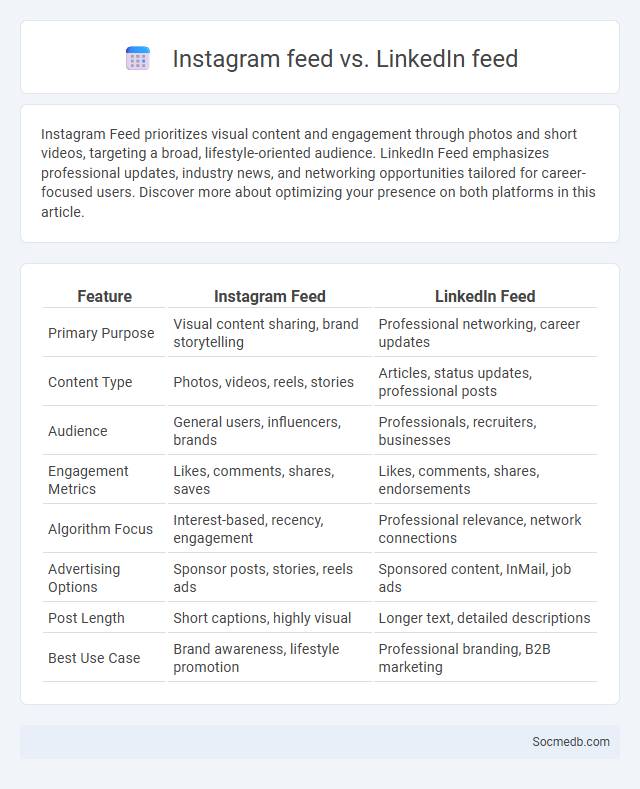
Photo illustration: Instagram Feed vs Linkedin Feed
Instagram Feed prioritizes visual content and engagement through photos and short videos, targeting a broad, lifestyle-oriented audience. LinkedIn Feed emphasizes professional updates, industry news, and networking opportunities tailored for career-focused users. Discover more about optimizing your presence on both platforms in this article.
Table of Comparison
| Feature | Instagram Feed | LinkedIn Feed |
|---|---|---|
| Primary Purpose | Visual content sharing, brand storytelling | Professional networking, career updates |
| Content Type | Photos, videos, reels, stories | Articles, status updates, professional posts |
| Audience | General users, influencers, brands | Professionals, recruiters, businesses |
| Engagement Metrics | Likes, comments, shares, saves | Likes, comments, shares, endorsements |
| Algorithm Focus | Interest-based, recency, engagement | Professional relevance, network connections |
| Advertising Options | Sponsor posts, stories, reels ads | Sponsored content, InMail, job ads |
| Post Length | Short captions, highly visual | Longer text, detailed descriptions |
| Best Use Case | Brand awareness, lifestyle promotion | Professional branding, B2B marketing |
Introduction to Social Media Feeds
Social media feeds aggregate real-time content from various sources, delivering personalized updates directly to your device. Algorithms analyze your interactions to prioritize relevant posts, ensuring your feed reflects interests, preferences, and connections. Understanding how these feeds operate helps you better manage your online experience and stay informed efficiently.
What is an Instagram Feed?
An Instagram Feed is a curated collection of photos and videos displayed on a user's profile, showcasing their personal or brand identity through visual storytelling. It serves as the main interface where followers engage with posts via likes, comments, and shares, shaping the user's online presence and influence. Effective Instagram Feed management involves strategic content planning, consistent aesthetics, and leveraging hashtags to maximize reach and follower growth.
Overview of LinkedIn Feed
LinkedIn Feed is a tailored content stream designed to enhance your professional networking experience by delivering industry news, job updates, and relevant posts from your connections. The algorithm prioritizes content based on your interactions, profile, and professional interests, ensuring that you see the most pertinent information for career growth. Engaging actively with the feed can increase your visibility and foster meaningful connections within your industry.
Defining a Generic Social Media Feed
A generic social media feed aggregates diverse content including text posts, images, videos, and links from various sources such as friends, pages, and groups you follow. Algorithms personalize your feed by analyzing engagement metrics like likes, shares, comments, and time spent to prioritize relevant and timely information. Understanding how this dynamic feed operates empowers you to optimize your content visibility and interaction on platforms like Facebook, Instagram, and Twitter.
Content Types: Instagram vs LinkedIn vs Generic Feed
Instagram specializes in visually-driven content, emphasizing images, short videos, and Stories to engage users through vibrant, creative storytelling. LinkedIn prioritizes professional and educational content, including in-depth articles, industry news, and career-related updates that foster networking and knowledge sharing. Your strategy should align with these platforms' unique content types to maximize reach and engagement within your target audience across the generic social media feed.
Audience and Engagement Differences
Social media platforms exhibit significant audience and engagement differences based on demographics, content type, and user behavior patterns. Instagram typically attracts younger audiences with a preference for visual content, resulting in higher engagement rates through likes and comments compared to Twitter, where concise text and real-time updates drive interactions primarily in news and professional sectors. Facebook's diverse user base fosters varied engagement types, including shares and group discussions, making it effective for community building and targeted advertising campaigns.
Algorithms: How Each Feed Curates Content
Social media algorithms analyze user behavior, preferences, and engagement patterns to curate personalized content feeds on platforms like Facebook, Instagram, and TikTok. These algorithms prioritize posts, videos, and ads based on relevance, recency, and predicted interest, using machine learning models and data from likes, shares, comments, and watch time. The continuous refinement of algorithmic criteria ensures users receive a dynamic, tailored experience that maximizes interaction and platform retention.
Best Practices for Posting on Each Feed
Maximizing engagement on social media requires tailoring content to each platform's unique algorithm and audience preferences. Instagram thrives on high-quality visuals and timely use of hashtags, while Twitter demands concise, timely updates with trending keywords. Facebook benefits from a mix of engaging videos, interactive polls, and optimized post timing to boost reach and interaction.
Branding and Marketing Strategies per Platform
Effective branding and marketing strategies vary across social media platforms to maximize your audience reach and engagement. Instagram emphasizes visually appealing content and influencer partnerships to build brand identity, while LinkedIn focuses on professional networking and thought leadership through targeted content and B2B marketing. Facebook leverages community groups and personalized ads for direct customer interaction, whereas Twitter highlights real-time engagement and hashtag campaigns to boost brand visibility.
Choosing the Right Feed for Your Goals
Selecting the right social media feed aligns with your specific goals, whether it's increasing brand awareness, driving website traffic, or building community engagement. Understanding platform algorithms and user behavior on feeds like Instagram, TikTok, or LinkedIn helps tailor content that optimizes reach and interaction. Your success depends on targeting feeds that resonate with your audience's preferences and your overall marketing strategy.
 socmedb.com
socmedb.com